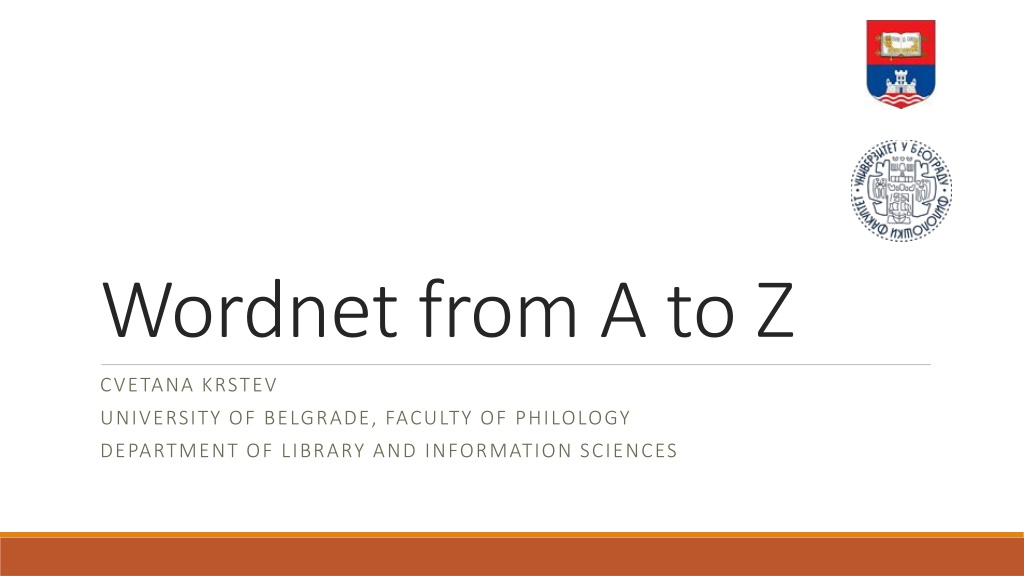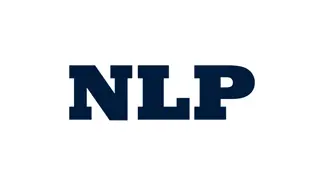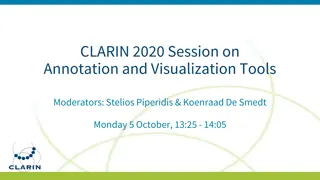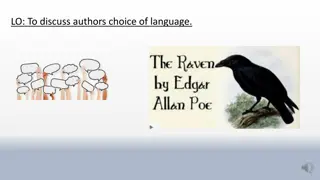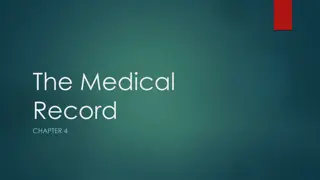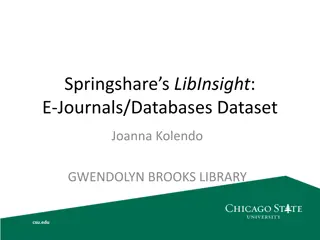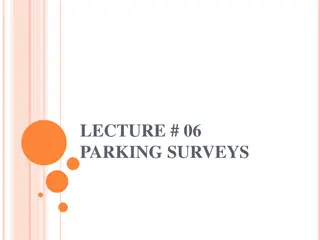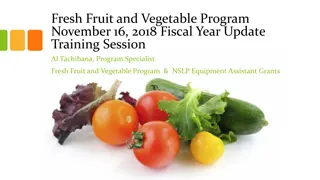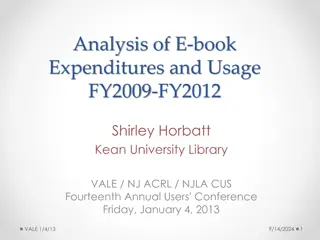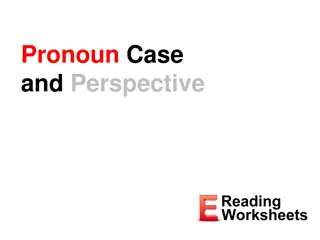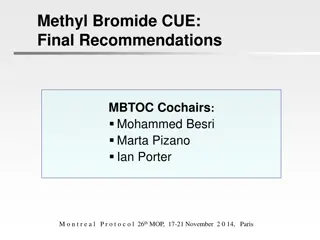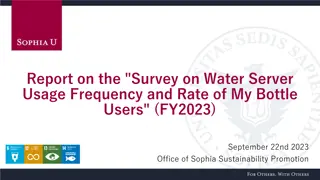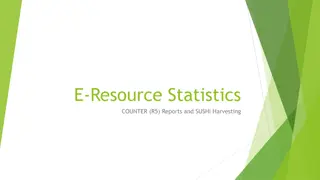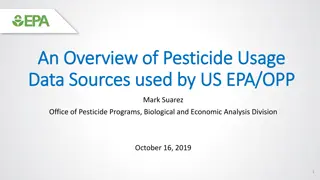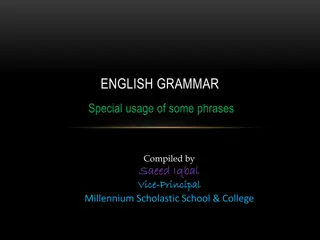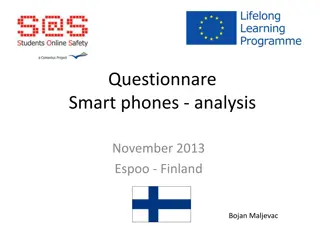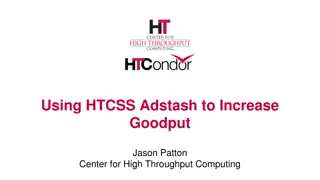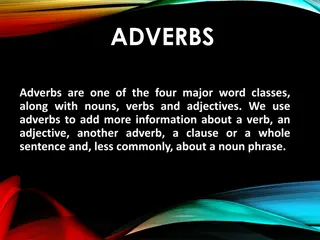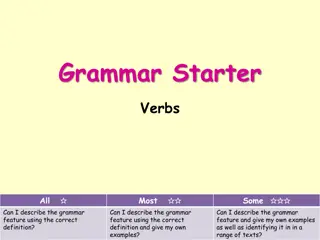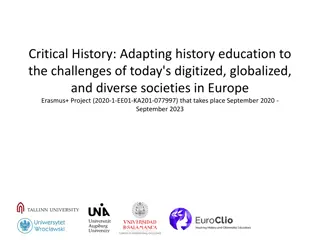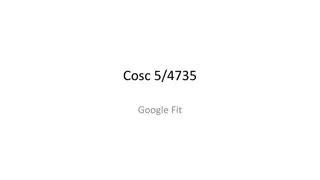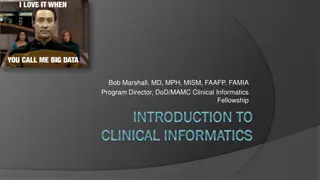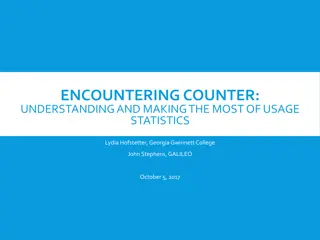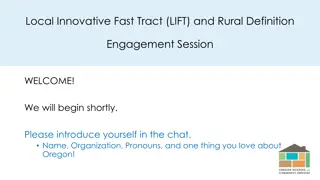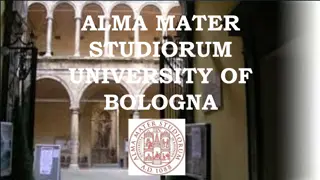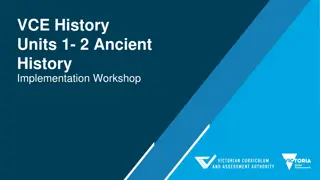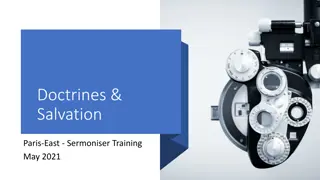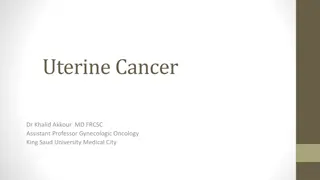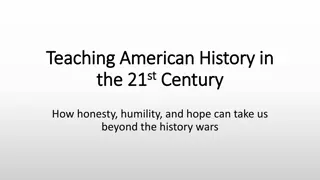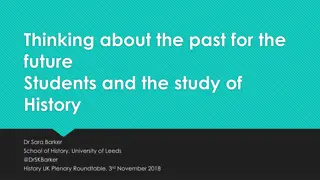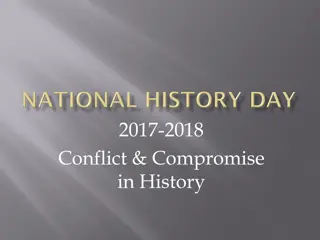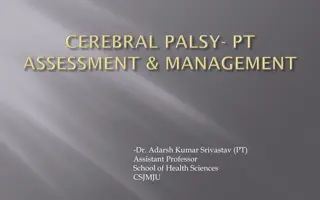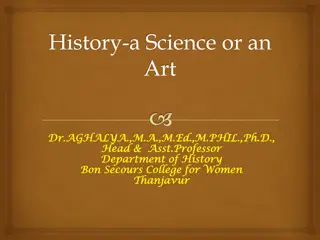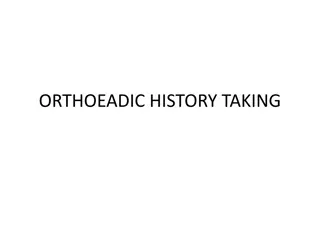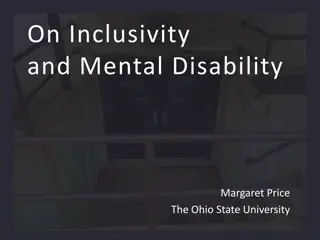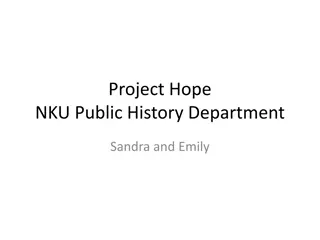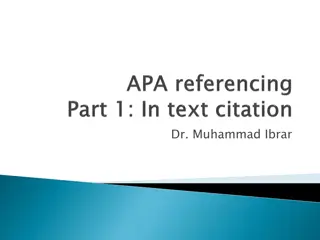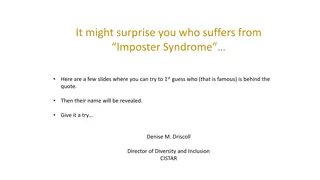Overview of WordNet: History, Definition, Authors, and Usage
WordNet is a lexical database for the English language, grouping words into synonym sets, providing definitions, and recording relations among these sets. It serves as a dictionary and thesaurus, with primary use in text analysis and AI. Created at Princeton University under George Miller and directed by Christiane Fellbaum, WordNet offers valuable insights into human lexical memory. Authors highlight its design inspired by psycholinguistic theories and the importance of utilizing computational power effectively in word studies. Detailed content includes WordNet's inception, purpose, and unique features in the realm of language analysis.
Download Presentation

Please find below an Image/Link to download the presentation.
The content on the website is provided AS IS for your information and personal use only. It may not be sold, licensed, or shared on other websites without obtaining consent from the author. Download presentation by click this link. If you encounter any issues during the download, it is possible that the publisher has removed the file from their server.
E N D
Presentation Transcript
Wordnet from A to Z CVETANA KRSTEV UNIVERSITY OF BELGRADE, FACULTY OF PHILOLOGY DEPARTMENT OF LIBRARY AND INFORMATION SCIENCES
Outline of my talk History What is WordNet? A Concept vs. Lexical form Relations Practice Development Projects Usage Enhancements Wordnets in the world 2
What Wikipedia says about WordNet WordNet is a lexical database for the English language. It groups English words into sets of synonyms called synsets, provides short definitions and usage examples, and records a number of relations among these synonym sets or their members. WordNet can thus be seen as a combination of dictionary and thesaurus. While it is accessible to human users via a web browser, its primary use is in automatic text analysis and artificial intelligence applications. (?) The database and software tools have been released under a BSD style license and are freely available for download from the WordNet website. Both the lexicographic data (lexicographer files) and the compiler (called grind) for producing the distributed database are available. 4
Authors of the (first) WordNet WordNet was created in the Cognitive Science Laboratory of Princeton University under the direction of psychology professor George Armitage Miller starting in 1985 and has been directed in recent years by Christiane Fellbaum That is why it is usually called the Princeton WordNet (PWN) George Miller and Christiane Fellbaum were awarded the 2006 Antonio Zampolli Prize for their work with WordNet. 5
What do authors say about this resource? Abstract: WordNet is an on-line lexical reference system whose design is inspired by current psycholinguistic theories of human lexical memory. English nouns, verbs, and adjectives are organized into synonym sets, each representing one underlying lexical concept. Different relations link the synonym sets. Miller, George A., et al. "Introduction to wordnet: An on-line lexical database*." International journal of lexicography 3.4 (1990): 235-244. More details can be found in 5papers : http://wordnetcode.princeton.edu/5papers.pdf 6
What do authors say about this resource? Summary: In a modern, computer era, alphabetic search for words is not enough; ...however,... it is grossly inefficient to use these powerful machines as little more than rapid page-turners. Beginning with word association studies at the turn of the century ..., psycholinguists have discovered many synchronic properties of the mental lexicon that can be exploited in lexicography. The initial idea was to provide an aid to use in searching dictionaries conceptually, rather than merely alphabetically it was to be used in close conjunction with an on-line dictionary of the conventional type. 7
Synset the basic unit of WordNet o Synset synonym set; o A synset is a representation of a concept a definition is added only to facilitate development and usage; o Instead of talking about words , when talking about WordNet, in order to reduce ambiguity word form or literal is used to refer to the physical utterance or superficial form and word meaning to refer to the lexicalized concept that a form can be used to express. o These synonym sets (synsets) do not explain what the concepts are; they merely signify that the concepts exist. 8
A wordform concept relation o This relation is many-to-many o Example: o{board, plank} and used for many purposes o{board, table} and board - def: a stout length of sawn timber; made in a wide variety of sizes - def: food or meals in general; usage: she sets a fine table ; room o A concept can be lexicalized by several word forms (one concept two word forms, board and plank) o A word form can be used for lexicalization of several concepts (one word form board can be used for two and many more concepts) 9
What are synonyms? According to one definition two expressions are synonymous if the substitution of one for the other never changes the truth value of a sentence in which the substitution is made. By that definition, true synonyms are rare, if they exist at all. A weakened version of this definition would make synonymy relative to a context: two expressions are synonymous in a linguistic context C if the substitution of one for the other in C does not alter the truth value. For example, the substitution of plank for board will seldom alter truth values in carpentry contexts, although there are other contexts of board where that substitution would be totally inappropriate. It is convenient to assume that the relation is symmetric: if x is similar to y, then y is equally similar to x. 10
Partitioning of WordNet o The definition of synonymy in terms of substitutability makes it necessary to partition WordNet into nouns, verbs, adjectives, and adverbs. o If concepts are represented by synsets, and if synonyms must be interchangeable, then words in different syntactic categories cannot be synonyms (cannot form synsets) because they are not interchangeable. o Nouns express nominal concepts, verbs express verbal concepts, and modifiers provide ways to qualify those concepts. o The use of synsets to represent word meanings is consistent with psycholinguistic evidence that nouns, verbs, and modifiers are organized independently in semantic memory. 11
Other relations - antonymy o The antonym of a word x is sometimes not-x, but not always. For example, rich and poor are antonyms, but to say that someone is not rich does not imply that they must be poor. o Antonymy is a symetric relation; o Antonymy is a lexical relation between word forms, not a semantic relation between word meanings. o Example: the meanings {rise, ascend} and {fall, descend} are conceptual opposites, but they are not antonyms; rise/fall and ascend/descend are antonyms but most people would reject rise and descend, or ascend and fall, as antonyms 12
Hyponymy/hypernymy (1) o Called also subordination/superordination, subset/superset, or the ISA relation) o hyponymy/hypernymy is a semantic relation between word meanings, not a lexical relation between word forms. o Example: {maple} is a hyponym of {tree}, and {tree} is a hyponym of {plant} o A concept represented by the synset {x, x ,...} is a hyponym of the concept represented by the synset {y, y ,...} if one can say (in English) An x is a (kind of) y . 13
Hyponymy/hypernymy (2) o Hyponymy is transitive and asymmetrical, and, since there is normally a single superordinate, it generates a hierarchical semantic structure, in which a hyponym is said to be below its superordinate. o A hyponym inherits all the features of the more generic concept and adds at least one feature that distinguishes it from its superordinate and from any other hyponyms of that superordinate o Example: maple inherits the features of its superordinate, tree, but is distinguished from other trees by the hardness of its wood, the shape of its leaves, the use of its sap for syrup, etc. o This relation is the central organizing principle for the nouns in WordNet, also for verbs, but noun hierarchy is mush deeper. 14
Meronymy/holonymy (1) o Called also part-whole or HASA relation o A concept represented by the synset {x, x ,...} is a meronym of a concept represented by the synset {y, y ,...} if one can say (in English) that A y has an x(as a part) or An x is a part of y . o The meronymic relation is transitive (with qualifications) and asymmetrical o It can be used to construct a part hierarchy o Example: {mouth, muzzle} is a meronym of {face, countenance} {wheel} is a meronym of {wheeled vehicle} (not of {vehicle}, because there are vehicles without wheels - parts are not inherited upward ) 15
WordNet in practice Princeton Wordnet o Example of one noun synset: o Synset {dog, domestic_dog, Canis_familiaris} o Definition a member of the genus Canis (probably descended from the common wolf) that has been domesticated by man since prehistoric times; occurs in many breeds; o Usage "the dog barked all night" 16
Dog upward hierarchy {entity} {physical_entity} {object, physical_object} {whole, unit} {living_thing, animate_thing} {organism, being} {animal, animate_being, beast, brute, creature, fauna} {chordate} {vertebrate, craniate} {mammal, mammalian} {placental, placental_mammal, eutherian, eutherian_mammal} {carnivore} {canine, canid} {dog, domestic_dog, Canis_familiaris} {domestic_animal, domesticated_animal} 17
Dog downward hierarchy {dog, domestic_dog, Canis_familiaris} {puppy_dog} {hunting_dog} {hound, hound_dog} {basset, basset_hound} {working_dog} ... 18
25 unique beginners for noun synsets {act, action, activity} {food} {possession} {animal, fauna} {location, place} {process} {artifact} {motive} {quantity, amount} {attribute, property} {group, collection} {relation} {body, corpus} {natural object} {shape} {cognition, knowledge} {natural phenomenon} {state, condition} {communication} {person, human being} {substance} {event, happening} {plant, flora} {time} {feeling, emotion} 19
Organization of top levels entity abstraction physical entity physical object process substance psychological_feature attribute relation location state shape whole, unit natural object living thing artifact organism person animal plant 20
Dog additional relations o MemberHolonym {Canis, genus_Canis} Def:type genus of the Canidae: domestic and wild dogs; wolves; jackals {pack} (dog is a member of a pack) Def: a group of hunting animals o PartMeronym {flag} (flag is a part of a dog) Def: a conspicuously marked or shaped tail 21
Meronymy/holonymy (2) Three types of meronymy/holonymy relation: PartHolonym (mouse button is a part of a computer mouse) {mouse, computer_mouse} (def: a hand-operated electronic device that controls the coordinates of a cursor... {mouse_button} (Def: a push button on the mouse) MemberHolonym (a rodent is a member of Rodentia) {rodent, gnawer} (def: relatively small placental mammals having a single pair of constantly growing incisor...) {Rodentia, order_Rodentia} (def: small gnawing animals: porcupines; rats; mice; squirrels; marmots; beavers; gophers; ...) SubstanceHolonym (protein is a substance of milk) {protein} (def: any of a large group of nitrogenous organic compounds that are essential constituents of living beings) {milk} (def: a white nutritious liquid secreted by mammals and used as food by human beings) 22
Antonymy between different Part-of- Speech Verbs {open, open_up} def: cause to open or to become open; Antonym: {close, shut} def: move so that an opening or passage is obstructed; make shut; Nouns {sadness, unhappiness} def: emotions experienced when not in a state of well-being Antonym: {joy, joyousness, joyfulness} def: the emotion of great happiness Adjectives {ugly} def: displeasing to the senses {beautiful} def: delighting the senses or exciting intellectual or emotional admiration; 23
To fry (shallow) hierarchy {fry}: cook on a hot surface using fat; "fry the pancakes {change} {change_integrity} {cook} {fry} {frizzle} {deep-fat-fry} {pan-fry} ... 24
Verb clusters Verbs of Bodily Functions and Care (sweat) Motion Verbs (move) Verbs of Change (change) Emotion or Psych Verbs (feel) Verbs of Communication (tell) Stative Verbs (have, wear) Competition Verbs (race) Perception Verbs (see) Consumption Verbs (drink) Verbs of Possession (possess, own) Contact Verbs (touch) Verbs of Social Interaction (request, impeach) Cognition Verbs (think) Weather Verbs (thunder) Creation Verbs (create) 25
Other verb relations Cause (1) {burn, combust} def: cause to burn or combust; Usage: "The sun burned off the fog"; "We combust coal and other fossil fuels {burn, combust} def: undergo combustion; Usage: "Maple wood burns well Cause (2) {feed, give} Def: give food to Usage: "Feed the starving children in India"; {eat} Def: take in solid food; Usage: "She was eating a banana" 26
Other verb relations (2) Entailment - the relation between two verbs V1 and V2 that holds when the sentence Someone V1 logically entails the sentence Someone V2 {abort}: terminate a pregnancy by undergoing an abortion} entails {conceive}: become pregnant; undergo conception {snore, saw_wood, saw_logs}: breathe noisily during one's sleep entails {sleep, kip, slumber, log_Z's, catch_some_Z's}: be asleep 27
Other relations Cross-Part-Of-Speech Attribute: adjective {perfect} noun {perfection, flawlessness, ne_plus_ultra} Adjective {clean} noun {cleaness} Derivationally related: Verb {abort} noun {abortion} Adjective {dirty, soiled, unclean} - noun {dirtiness, uncleanness} Similar (all Part-Of-Speach} Adjective {dirty, soiled, unclean} - {unwashed}, {sooty}, {maculate}, {greasy, oily}... SeeAlso (all Part-Of-Speach} Adjective {dirty, soiled, unclean} - {untidy} 28
TopicDomain {cooking, cookery, preparation}: the act of preparing something (as food) by the application of heat Verb {fry}: cook on a hot surface using fat Noun {curry}: (East Indian cookery) a pungent dish of vegetables or meats flavored with curry powder and usually eaten with rice {sport, athletics}: an active diversion requiring physical exertion and competition} Adjective {loose}: (of a ball in sport) not in the possession or control of any player Noun {offside}: (sport) the mistake of occupying an illegal position on the playing field (in football, soccer, ice hockey, field hockey, etc.) Verb {shoot}: score; "shoot a basket"; "shoot a goal" 29
InstanceHyponym {athlete, jock} {player, participant} {tennis_player} {receiver} {tennis_pro, professional_tennis_player} {Evert, Chris_Evert, Chrissie_Evert, Christine_Marie_Evert} {King, Billie_Jean_King, Billie_Jean_Moffitt_King} {Navratilova, Martina_Navratilova} {Seles, Monica_Seles} Novak okovi ? 30
WordNet 3.0 statistics (according to Piek Vossen, VU University Amsterdam) POS Noun Verb Adjective Adverb Unique strings 117,798 Synsets 82,115 13,767 18,156 3,621 Word-Sense Pairs 146,312 25,047 30,002 5,580 11,529 21,479 4,481 Total 155,287 117,659 206,941 31
Projects 32
EuroWordNet (project: March 1996 June 1999) o EuroWordNet is a multilingual database with wordnets for several European languages (Dutch, Italian, Spanish, German, French, Czech and Estonian). o The wordnets are structured in the same way as the American wordnet for English in terms of synsets (sets of synonymous words) with basic semantic relations between them. o Each wordnet represents a unique language-internal system of lexicalizations. o In addition, the wordnets are linked to an Inter-Lingual-Index, based on the Princeton wordnet. Via this index, the languages are interconnected so that it is possible to go from the words in one language to similar words in any other language. o The index also gives access to a shared top-ontology of 63 semantic distinctions. This top-ontology provides a common semantic framework for all the languages 33
Vossen, P. "From WordNet to EuroWordNet to the Global WordNet Grid: anchoring languages to universal meaning." Guest lecture, Language Engineering Applications, February, 26th (2009). 34
Multilingual Balkan Wordnet IST-2000-29388 [September 2001 August 2004 ] The project consortium consisted of 13 institutions from: Bulgaria Greece Romania Serbia Turkey France Nederland Czech Republic http://www.dblab.upatras.gr/balkanet/index.htm http://www.dblab.upatras.gr/balkanet/index.htm 35
The aims of the BalkaNet project o The development of the multilingual resources for the Balkan languages (Bulgarian, Greek, Romanian, Serbian, Turkish, and Czech) o The enhancement of the semantic network EuroWordNet o The definition of Balkan specific concepts o The integration of semantic networks into applications based on natural language processing (e.g. classification of web documents) 36
Development models There are two main models for building a multilingual wordnet: A merge model A merge model consists of building a language specific wordnet independently from other wordnets (and from PWN) Used in EuroWordnet (in a second phase the correspondences between individual wordnets was established), Polish Wordnet (plWordNet 2.0) A A expand model expand model (translation-based model) consists of building a language specific wordnet keeping as much as possible of the semantic relations available in PWN. This is done by building the new synsets in correspondence with the PWN synsets, whenever possible, and importing semantic relations from the corresponding English synsets; Used in Balkanet project and many other projects 38
Balkan specific concepts o a concept specific for a particular Balkan language ( foreign currency saving accounts frozen by factual bankruptcy for Serbian), o a concept originating from one Balkan language which has spread to other Balkan and European languages ( the assassination in Sarajevo ), o a concept which is not necessarily specific for the Balkans only, but which is recognized as common in this area, while at the same time it has not been registered in PWN ( banks offering extremely high interest rates ). 39
Concepts recognized by all Balkan languages Bulgarian Bulgarian Greek Greek Romanian Romanian cataif Serbian Serbian Turkish Turkish cataif kaday f kaday f halva halva ka t ka t helva helva 40
Enhancements 41
Wordnet Domain Hierarchy The WordNet Domains Hierarchy (WDH resource composed of 164, hierarchically organized, domain labels (e.g. Architecture, Sport, Medicine). WordNet Domains is a lexical resource developed at ITCirst where each WordNet synset is annotated with one or more domain labels selected from a domain hierarchy which was specifically created to this purpose. The first version of the WDH was composed of 164 domain labels selected starting from the subject field codes used in current dictionaries, and the subject codes contained in the Dewey the Dewey Decimal general knowledge organization tool which is the most widely used taxonomy for library organization purposes. More info: http://wndomains.fbk.eu/index.html WDH) is a language-independent Decimal Classification Classification (DDC) (DDC), a 42
One of the five main trees in the WordNet Domains original hierarchy Other 4 trees are: free_time applied_science pure_science social_science The label FACTOTUM was assigned in case all other labels could not be assigned. 43
One word many labels (domains) example board board Synset definition domain a flat portable surface (usually rectangular) designed for board game play a printed circuit that can be inserted into expansion slots in a computer to increase ... computer science electrical device consisting of a flat insulated surface that contains switches ... electronics a table at which meals are served furniture a vertical surface on which information can be displayed to public view electronics food or meals in general food a flat piece of material designed for a special purpose factotum a stout length of sawn timber; made in a wide variety of sizes and used for many purpose buildings a committee having supervisory powers administration 44
SUMO The Suggested Upper Merged Ontology (SUMO) o An ontology is a set of definitions in a formal language for terms describing the world. o An Upper Ontology is an attempt to capture the most general and reusable terms and definitions. o SUMO: o 1000 terms, 4000 axioms (assertions), 750 rules; o Mapped by hand to all of WordNet 1.6; o then ported to newer versions o Associated domain ontologies totaling 20,000 terms and 60,000 axioms; o Free o SUMO is owned by IEEE but basically public domain o Domain ontologies are released under GNU o www.ontologyportal.org 45
Adam Pease Articulate Software Presented at PANL1On 46
Relations between SUMO concepts and Wordnet Synsets o Synonymy o {battle, conflict, fight, engagement} -> SUMO Battle= (Domain: history) o Subordination o {naval_battle} -> SUMO Battle+ (Domain: history) o Instance o {Trafalgar, battle_of_Trafalgar} -> SUMO Battle@ (Domain:history) o Less straightforward o {writer, author} -> SUMO authors= (Domain: literature) o {dramatist, playwright} -> SUMO Position+ (Domain: literature) o {poet} -> SUMO authors+ (Domain: literature) o {Brecht, Bertolt_Brecht} -> SUMO Man@ (Domain:literature) 48
Wordnet to SUMO Mapping and SUMO formalism {plant, flora, plant_life}: (botany) a living organism lacking the power of locomotion SUMO: Plant = (domain: biology SUMO has axioms that explain formally what a plant is (=> (and (instance ?SUBSTANCE PlantSubstance) (instance ?PLANT Organism) (part ?SUBSTANCE ?PLANT)) (instance ?PLANT Plant)) 49
Why are SUMO and WordNet important oSemantic word sense disambiguation o The board approved the pay raise. o Piece of wood, or corporate government? oAnaphoric resolution o Betty saw Susan asleep on the couch. She put her to bed. o Sleeping people do not perform intentional actions 50
